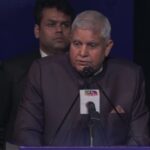
NEW DELHI, 17 JUNE: On June 9, 2025, the Narendra Modi-led NDA government completed 11 years at the Centre. The occasion was marked by an elaborate public outreach campaign, underscoring what the ruling Bharatiya Janata Party termed “11 years of service, good governance, and resolve.”
The campaign was carefully choreographed to project continuity, leadership, and policy success across sectors. However, as the promotional drive gathered momentum, it was abruptly disrupted by a major civil aviation disaster—a Boeing aircraft crashed while landing at Ahmedabad airport, resulting in the loss of over 270 lives. The disturbing images and the ensuing public discourse brought a sobering pause to the celebratory narrative.
The BJP had envisioned the anniversary not merely as a symbolic milestone, but as a strategic moment of political consolidation. On June 9, BJP President J.P. Nadda addressed a press conference at the party headquarters, outlining the government’s key accomplishments. Subsequently, on June 11, a high-profile media interaction was hosted at the Bharat Mandapam convention centre in New Delhi, where senior Union Ministers engaged with journalists, presenting progress reports from their respective ministries. The dominant theme positioned “development” in opposition to “dynastic politics.”
Yet, behind the scenes, certain cracks surfaced. According to individuals present, informal conversations revealed internal disagreements, particularly on the political use of military operations. One senior Cabinet Minister reportedly questioned the wisdom of projecting Operation Sindoor—a recent cross-border military retaliation—as part of the domestic campaign. Nevertheless, government communication had already amplified the operation as a symbol of India’s assertive defence posture.
The government’s intent was to transform the anniversary into a pre-election “master narrative,” ahead of key electoral battles in Bihar and other states. Ministries were instructed to prepare short-form content, highlight achievements, and measure public engagement. Ministers were encouraged to disseminate video messages, showcase development work, and link these efforts to the Prime Minister’s leadership.
Journalists were taken on curated visits to project sites—be it redeveloped railway stations, piped water supply schemes, or Digital India installations. The overall tone projected India as modernising swiftly under a stable, strong-willed government.
However, the Ahmedabad crash disrupted this rhythm. The gravity of the incident—occurring in full public view and unfolding rapidly across social media—raised uncomfortable questions on civil aviation safety, emergency preparedness, and institutional accountability.
In such a backdrop, the optics of celebration were perceived as jarring. Opposition leaders and sections of the media questioned the appropriateness of continuing with political messaging amid national grief. Recognising the shift in public sentiment, the government recalibrated. Certain programmes were scaled down, and instructions were issued to use sensitive and balanced language in public communication. Ministries were also asked to re-evaluate their media tone and timing.
Importantly, the BJP’s messaging was not confined to the present term. It drew heavily on achievements from the first two tenures—Article 370 abrogation, the Ram Mandir, Ujjwala Yojana, India’s G20 presidency, and digital financial inclusion. These were blended with a renewed emphasis on national security. Operation Sindoor, launched in response to a terror attack in Pahalgam, was portrayed as evidence of India’s changed strategic posture. Union Home Minister Amit Shah’s unequivocal declaration—that India would now respond to bullets with bombs—was a central part of the narrative.
The BJP’s Bihar campaign strategy was aligned with this messaging. With Chief Minister Nitish Kumar back in the NDA fold, the party planned to pitch “stability versus chaos” and “development versus dynasty” as key frames. The 11-year campaign was envisaged as its backbone. Beneficiary testimonials, campaign visuals, and data-driven storytelling were prepared for mass outreach.
But the aviation tragedy altered the mood. The party now faces the challenge of resuming its campaign without appearing tone-deaf. Whether it reverts to its earlier slogans—such as “11 years, 11 milestones”—or chooses a more restrained, humane narrative remains to be seen.
Early indications suggest a shift in tone. Ministers now frequently assert that the government is “not merely counting achievements, but impacting lives.” Such language marks a subtle turn towards empathy and measured outreach. Similarly, references to Operation Sindoor have significantly reduced in public discourse, particularly after former U.S. President Donald Trump claimed he helped broker a ceasefire. These assertions, and the Opposition’s criticism thereof, appear to have led the BJP to step back from overt militaristic rhetoric.
Ultimately, the 11-year celebration was not simply an exercise in statistics. It was a calibrated political strategy aimed at electoral resonance. However, the abrupt and tragic turn of events served as a reminder that public memory is shaped not only by grand narratives, but by how governments respond in moments of adversity.
Whether this milestone becomes a stepping stone for electoral consolidation or a reminder of vulnerability may well depend on how the coming months unfold.














No Comments: